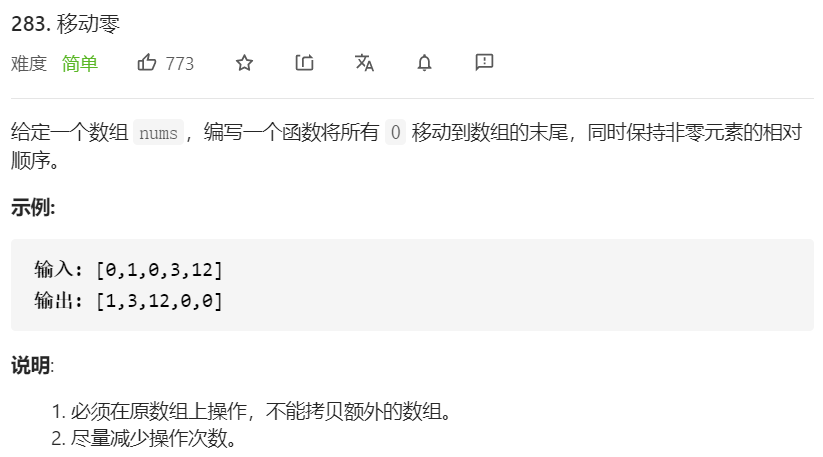题目
中文
https://leetcode-cn.com/problems/move-zeroes/submissions/
英文
https://leetcode.com/problems/move-zeroes/submissions/
283. Move Zeroes
Given an array nums, write a function to move all 0‘s to the end of it while maintaining the relative order of the non-zero elements.
Note:
- You must do this in-place without making a copy of the array.
- Minimize the total number of operations.
relative adj. 相对的
题解
第一次
个人思考
遍历数组发现0则删除该元素但不改变数组大小 并使用一个变量记录0的个数。
最后给末尾元素补0 ——-数组不应该考虑删除
所以 直接遍历数组 如果有0则寻找下一个不是零的 交换 没有则没事
交换之后再继续向后移动。
时间复杂度应该是O(N^2)
void moveZeroes(int *nums, int numsSize){for (int i = 0; i < numsSize; i++){if (nums[i] == 0){for (int j = i + 1; j < numsSize; j++){if (nums[j] != 0){int temp;temp = nums[j];nums[j] = nums[i];nums[i] = temp;break;}}}}return nums;}
讲解-第二次
思路:不用二层遍历
使用一个变量 j来记录下一个非0元素存放的位置。
有0挪到后面。这样复杂度变成O(n)
void moveZeroes(int *nums, int numsSize)
{
int j=0;//next non-negetive number location
for (int i = 0; i < numsSize; i++)
{
if(nums[i]!=0){
int temp;
temp=nums[j];
num[j]=nums[i];
nums[i]=temp;
j++;
}
}
return nums;
}
j来表示下一个非0元素位置
为什么不为0时要进行交换而不是直接赋值呢?
交换的话 当前位置数的值变成0 把非0元素放到了前面。
如果直接赋值的话,后面的部分还是原来的非0数字,最后应该加一次对后面元素赋值为0的操作。


